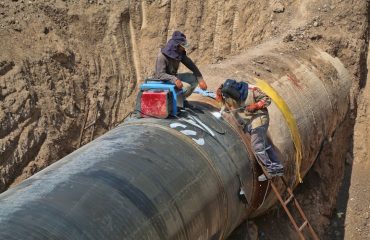Scaffolding is an indispensable element of modern construction, providing temporary support for workers and materials at various heights. At the heart of most scaffolding systems lies the humble scaffolding pipe – a seemingly simple component with a crucial role in ensuring worker safety and project success. This comprehensive guide delves into the world of scaffolding pipes, exploring their types, applications, safety considerations, erection procedures, and relevant regulations.
Types of Scaffolding Pipes Used in Construction
Scaffolding pipes aren’t all created equal. The choice of pipe depends on factors like project size, load capacity requirements, and environmental conditions. Common types include:
- Steel Scaffolding Pipes: These are the most prevalent type, known for their strength, durability, and relatively low cost. They are typically made from high-strength carbon steel and come in various diameters and lengths, conforming to specific industry standards. Galvanized steel pipes offer added protection against corrosion.
- Aluminum Scaffolding Pipes: Lighter than steel, aluminum pipes are preferred where weight is a concern, such as on elevated structures or in areas with restricted access. However, they are generally more expensive and less durable than steel.
- Composite Scaffolding Pipes: Made from fiberglass or other composite materials, these pipes offer excellent corrosion resistance and are often lighter than steel. They are a good option for environments with high humidity or corrosive chemicals, but their strength might be lower compared to steel.
Understanding the properties of each type is crucial for selecting the appropriate pipe for the specific construction task.
Safety Regulations and Standards for Scaffolding Pipes
Safety is paramount when working at heights. The use of scaffolding pipes is governed by strict regulations and standards designed to minimize the risk of accidents. These regulations vary by country and region, but common themes include:
- Regular Inspection: Scaffolding pipes must be inspected regularly for damage, corrosion, or signs of wear. Damaged pipes must be immediately replaced.
- Proper Erection and Dismantling: Scaffolding must be erected and dismantled by trained and competent personnel following established procedures.
- Load Capacity: The scaffolding must be designed and constructed to support the intended load, considering factors like worker weight, materials, and environmental conditions.
- Fall Protection: Appropriate fall protection measures, such as guardrails, toe boards, and safety nets, must be in place.
- Compliance with Standards: Scaffolding systems must comply with relevant national and international standards, such as OSHA (Occupational Safety and Health Administration) in the US or similar standards in other countries.
Ignoring safety regulations can lead to serious accidents and legal consequences.
Erection and Dismantling Procedures for Scaffolding Pipes
The erection and dismantling of scaffolding using pipes is a skilled task that requires careful planning and execution. Key steps include:
- Site Preparation: The ground must be level and stable to support the scaffolding. Any obstacles must be removed.
- Base Plate and Standards: The base plates are secured to the ground, and the vertical standards (pipes) are erected and braced.
- Ledgers and Transoms: Horizontal ledgers and transoms are attached to the standards to form the scaffolding platform.
- Diagonal Bracing: Diagonal bracing is crucial for stability, preventing the scaffolding from collapsing under load.
- Platform Construction: The platform is constructed using planks or decking, ensuring a safe and stable working surface.
- Dismantling: Dismantling should be carried out in the reverse order of erection, ensuring that the scaffolding is systematically disassembled without compromising safety.
Improper erection or dismantling can lead to structural failure and serious accidents. Only trained personnel should undertake these tasks.
Applications of Scaffolding Pipes in Various Construction Projects
Scaffolding pipes find applications across a wide range of construction projects, including:
- Building Construction: Scaffolding provides access to different levels during construction, allowing workers to reach various parts of the building.
- Bridge Construction: Scaffolding is essential for supporting workers and materials during bridge construction, especially for large spans.
- Industrial Construction: In industrial settings, scaffolding is used for maintenance, repairs, and construction of large-scale structures.
- Residential Construction: Even in smaller residential projects, scaffolding is often necessary for exterior work like painting, repairs, or window installation.
- Maintenance and Repair: Scaffolding is widely used for maintenance and repair work on existing buildings and structures.
The versatility of scaffolding pipes makes them adaptable to diverse construction needs.
Choosing the Right Scaffolding Pipes: Factors to Consider
Selecting the right scaffolding pipes involves careful consideration of several factors:
- Project Requirements: The size, height, and load capacity of the scaffolding will dictate the type and quantity of pipes needed.
- Material Selection: The choice between steel, aluminum, or composite pipes depends on factors like weight, corrosion resistance, and budget.
- Diameter and Length: Pipes are available in various diameters and lengths, and the appropriate size should be selected based on the project requirements and load capacity.
- Compliance with Standards: Pipes must comply with relevant safety standards and regulations to ensure structural integrity and worker safety.
- Supplier Reputation: Choosing a reputable supplier ensures that the pipes meet the required quality and standards.
Careful consideration of these factors is essential for ensuring a safe and effective scaffolding system.
In conclusion, scaffolding pipes are fundamental components in construction, playing a critical role in ensuring worker safety and project success. Understanding the different types, safety regulations, erection procedures, applications, and selection criteria is vital for anyone involved in construction projects. By adhering to safety standards and best practices, we can ensure that scaffolding remains a safe and effective tool for building the structures that shape our world.




